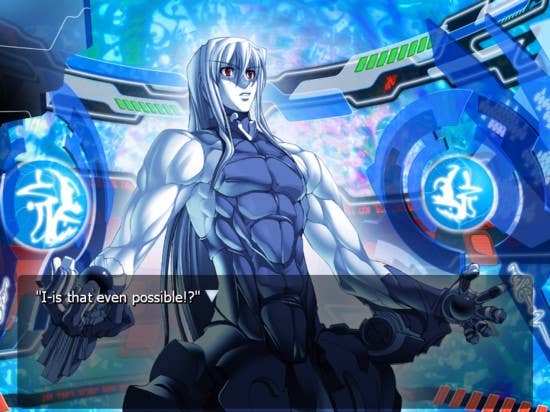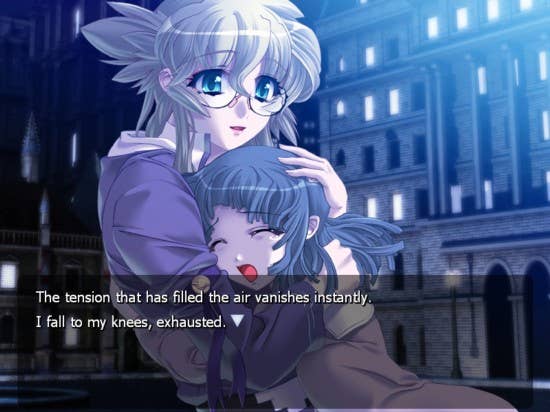JPgamer: From the Folks Who Brought You Steins;Gate: Lovecraft Meets Giant Robots
The recently localized Steins;Gate may be Nitroplus' most well-known work, but an earlier title from the developer is still a fascinating read for those of you with strong stomachs.
This article first appeared on USgamer, a partner publication of VG247. Some content, such as this article, has been migrated to VG247 for posterity after USgamer's closure - but it has not been edited or further vetted by the VG247 team.
Played Steins;Gate yet? If not, here's why you should. If you have, you may be curious as to what else developer Nitroplus has given the world over the years.
Today I'd like to talk specifically about one of the company's much earlier titles: Deus Machina Demonbane. This title originally came out in Japan back in 2003 but only saw a Western release a few years ago in 2011 courtesy of visual novel localization specialists JAST USA. Its PC incarnation -- the tamer PS2 version never made it out of Japan -- is an eroge, meaning that it features explicit content, but for reasons that will become apparent shortly, to describe it as in any way "erotic" is exceedingly misleading. If you really must pin it down, it's a horror title in the Lovecraftian mold. Only it's also got elements of noir. Oh, and giant robots.

It's an exceedingly odd combination, but one that works surprisingly well. The protagonist of the piece is one Daijuuji Kurou, a down-on-his-luck private investigator living in Arkham City, who is recruited by the super-rich Ruri Hadou of the Hadou Financial Group to track down a magic book. Said book turns out to be the Necronomicon, but in a strange twist on the usual way this sort of thing tends to unfold, the grimoire has the ability to take human form and indeed usually does.
The Necronomicon's personification in Demonbane is a young-looking girl called Al who, once discovered, quickly forms a contract with Kurou and then proceeds to accompany him on an increasingly bizarre adventure. Although she looks young and frail, Al is a spunky, somewhat arrogant and short-tempered young woman who provides both an excellent complement to Kurou's world-weariness and, over time, a positive influence on the embittered detective. She's an extremely well-realized character, and the complex relationship between her and Kurou is explored in some depth over the course of one of the game's main narrative paths. She also provides a considerable amount of comic relief throughout the game -- an important role in the grand scheme of things, since things get very dark over the course of the whole story.

Where Demonbane differs a little from some other visual novels -- particularly those that err a little more towards the "dating sim" side of things -- is in its narrative perspective. Rather than unfolding exclusively from Kurou's first-person perspective, the game isn't at all afraid to cut away and show what is going on elsewhere, and when it does, it does so using authentically overblown and melodramatic Lovecraftian third-person narration. In doing so, it helps to emphasize the gravity of the whole situation that Kurou, Al and the other members of the cast find themselves embroiled in over the course of the game's lengthy plot. Similarly, although unfolding largely through static images, some evocative narration combined with striking visuals and complementary music makes the game's "action" sequences -- which is where the giant robots usually come in -- as dramatic and exciting as if they were fully animated or interactive.
Like a good book, the strong characterization and descriptive narrative are the tools through which Demonbane draws you in and interests you, and it's through these same tools that it manages to horrify and repulse extremely effectively. The game features some utterly loathsome villains, many of whom are drawn from Lovecraft's mythos and later authors who built on his work, and it doesn't hold back from putting its characters -- both male and female -- in some seriously unpleasant situations, usually tying in with the explicit content. There's not a single sexual scene in the game that is the slightest bit erotic or titillating, and this is entirely intentional: the game isn't about providing a flimsy excuse for some porn. Instead, it uses its sexual scenes as a means of making the player feel enormously uncomfortable, even in those scenes that are theoretically more "innocent" (for want of a better term) and less horrific than others. And this effect is achieved largely through well-crafted narration rather than excessively graphic artwork -- though there are one or two scenes you might need a strong stomach for.

This sort of treatment of sexual material isn't at all unusual in the visual novel medium, particularly in those titles that place greater emphasis on story than on any erotic content they might have. Song of Saya (also known as Saya no Uta) is another Nitroplus title that brings horror and sex together in a particularly wince-inducing (but enormously effective and engaging) package, and tamer titles such as Kana Little Sister, Katawa Shoujo and School Days make use of sexual content in a "non-erotic" manner to advance their narratives and emphasize the point that relationships are complicated, sex has meaning and isn't always a pleasurable experience. Even Steins;Gate, which doesn't feature any explicit sexual content, contemplates the darker side of human nature in some of its narrative paths; anyone who's seen Suzuha's ending and didn't get shivers down their spine at the things rattling around inside Okabe's head is a stronger person than I.
But I digress; it's easy to get hung up on the sexual side of things when it's actually a fairly minor part of the complete Demonbane experience. With three main narrative paths and about 20 hours' worth of story to explore on each playthrough -- though you can make use of the usual fast-forward function if you've already seen a scene -- Demonbane provides an exciting, interesting and well-crafted narrative that gradually grows in scope at a good pace as it proceeds. What begins as a personal tale about Kurou being down on his luck and how his life is turned upside-down by a new woman in his life -- a classic noir setup -- gradually builds into something seriously epic that I won't spoil here for those of you whose interest is piqued. Suffice to say the aforementioned giant robots and something of a "Lovecraft's Greatest Hits" lineup get involved throughout, but the game's "true" finale is surprising, dramatic and genuinely emotional.

While clearly somewhat dated now -- it runs in 4:3 aspect ratio, the visuals lack Steins;Gate's beautifully stylized layer of polish about them and the dialogue is only partially voiced throughout -- Demonbane ably demonstrates that Steins;Gate most certainly wasn't just a one-off success for Nitroplus. Rather, it represents a refinement of their interactive storytelling craft over time; Demonbane, even as a considerably older title, is still well worth checking out, particularly if you're interested in seeing just how the seemingly unworkable combination of Lovecraftian horror and giant robots can possibly work -- because work it absolutely does.
Find out more and grab a copy here.
